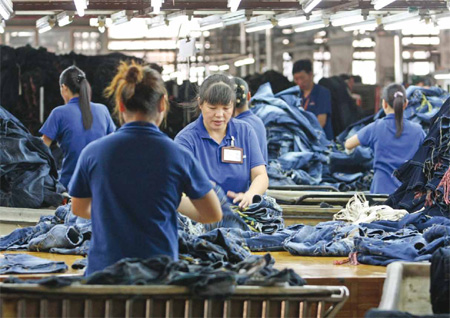We will start with giant denim and fashion jeans producer China. The world produces every year around 5 billion pieces of jeans.
China alone has around 300 denim mills of a total world figure of around 500 units (see below table from Wikipedia)
| Region | No. of Denim Mills |
|---|---|
| Asia (China) | 297 |
| Asia (other countries) | 104 |
| North America | 9 |
| Europe | 41 |
| Latin America | 46 |
| Africa | 15 |
| Australia | 1 |
| Total Denim Mills (World-wide) | 513 |
China internal growth and ever increasing GNP has been threatened by higher inflation. Domestic demand for garment products have increased drastically during the last two decades making China a net consumer of their own products. This fact has recently provoked a shift of export based production towards other countries in the area such as Vietnam, Cambodia, and other Asian countries. These days, well known brands from Europe, Italy and Japan are opening retail shops in China in order to sell their garments. Many Western brands have established not only buying offices in China but also product development offices with staff focused on developing the domestic market in China. Just to mention few companies, like Zara, Levis, H&M, Stradivarius, Abercrombie, Gap, BSK;C&A etc, all these companies have offices for their China´s expansion.
Some local manufacturers in China do not find attractive anymore to produce for export markets but they prefer to work for their domestic market because they know the local trends better, the profit margins can be increased, overhead costs smaller, and more simple management in their factories. Obviously China is still producing for export markets significantly but as the middle class keeps growing in China, more local people can afford fashion denim products. This increase of demand makes prices to climb and manufacturers are reluctant to work for lower margins. If we ad the current crisis situation in Europe and ups and down in US economy, the situation for export jeans from China seems that will keep shrinking.
Western buyers do require also strict controls for codes of conduct, environmental production requirements and labor laws. Although China has improved significantly still may be inland areas in such a big country
that cannot fullfill these requirements. This makes manufacturers or brands reluctant and not capable of implementing effectively those requirements. At the end of the day, these makes China jeans more expensive as well. China wages are keeping rising and putting pressure on manufacting costs.
There are areas in China such as Xintang city, near Guangzhou, that are highly specialized in jeans production. Hundreds or not thousands of small jeans producers are in the city. Also we can find some big producers as well that did production for important western brands.
This is known as the denim capital of China. A company named Conshing is a top producer in the country for denim products. http://www.conshing.com.cn/en/about.asp

China is and will be a key player in the jeans market in the following years. Domestic demand will keep increasing, therefore pushing prices upwards. As labor wages seem that will keep increasing in already established denim areas it makes sense to say that factories must move inland with lower production costs.
The jeans industry in China must do again what they did in western china 25 years back. However, I think this time will be easier because they have more experience and knowleadge of the business. If China takes seriously and agressive approach towards moving the jeans production to Eastern provinces, China will again dominate the denim business. Maybe now they are too busy taking care of their domestic demand and factory owners are not young enterpreneurs as they did 25 years back.
A new fashion jeans industrial revolution in China must take over sooner or later if they want to keep their export business growing in the long term.
We have seen in recent years that neighbouring lower wage countries in China such as Vietnam, Cambodia, Thailand, has taken over productions that traditionally has been done in China. In many instances denim fabric is made and exported to these countries where garments are stiched, washed and shipped. Company owners in China have established partnerships or ownerships in these countries in order to keep the control of the business and making it profitable. Maybe the constraint of these countries is that they are not producing big amounts of denim meaning that they are dependable on China or other countries that can supply the fabrics. There is obviously some risks involved on this external depedence.
A good jeans producer is Nien Hsing Textile Co., Ltd. http://www.nhjeans.com/en/

No comments:
Post a Comment
SHARE YOUR EXPERIENCE OR TARGETS